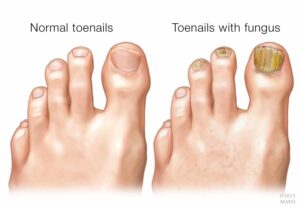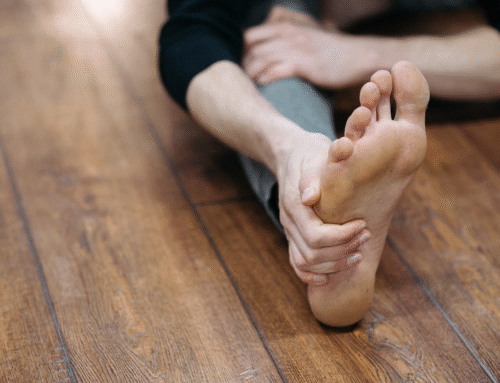There are many types of nail fungus infections. Understanding the different types of nail fungus infections is essential for proper diagnosis and treatment. Each infection uniquely affects the nail, and recognizing the specific symptoms can help determine the most effective care. Some infections start at the nail tip or surface, while others begin near the cuticle or affect the surrounding skin. Severity can range from mild discoloration to complete nail destruction if left untreated.
By learning the characteristics of each type, individuals can take more informed action when symptoms appear. Early detection often prevents complications and reduces the risk of long-term nail damage. Whether caused by dermatophytes or yeast, these infections thrive in moist environments and require prompt attention. Knowing the variations helps guide prevention, treatment, and long-term nail health.
Types of nail fungus infections
There are several types of nail fungus infections, each affecting the nail in different ways. Distal lateral subungual onychomycosis is the most common. It usually begins at the nail tip and spreads underneath. The nail often becomes thick, discolored, and brittle. White superficial onychomycosis affects the top surface of the nail. It causes white, chalky spots that may spread if untreated.
Another type is white superficial onychomycosis, which affects only the surface of the nail. It appears as white, powdery patches that can spread if untreated. The nail may become soft and flaky. This type responds well to early treatment.
Candida onychomycosis is caused by yeast and can affect both nails and surrounding skin. It mainly affects fingernails exposed to frequent moisture. It frequently leads to swelling and redness around the nail. Nail discoloration may vary from white to brown. Early identification of the infection type helps determine the best treatment method.
The more rare and severe types of nail fungus
Proximal subungual onychomycosis type is less common and begins at the nail base near the cuticle. It usually occurs in people with weakened immune systems. The infection slowly moves up the nail. This type may signal an underlying health issue.
Total dystrophic onychomycosis is the most severe form. It usually develops from a long-term, untreated infection. The entire nail becomes thick, discolored, and may detach. Nail damage is often permanent if left untreated.
How does nail fungus spread?
Nail fungus infections typically begin when fungal organisms—most often dermatophytes—enter the nail. They enter through small cracks, cuts, or separations between the nail and nail bed. These microscopic fungi thrive in warm, moist environments. These places include locker rooms, public showers, gyms, and swimming pools, making these places common sources of infection.
Once the fungus takes hold, it feeds on the keratin in the nail, gradually spreading deeper. It then causes discoloration, thickening, and brittleness. Wearing tight, closed-toe shoes for long periods can trap heat and moisture, creating ideal conditions for fungal growth. People who frequently wear sweaty socks, share nail tools, or walk barefoot in damp public areas are at higher risk of developing nail fungus.
The infection can also spread from one nail to another or from the skin to the nail. For example, when a person already has athlete’s foot, the same fungi that cause athlete’s foot can easily move to the nails if not treated promptly. Sharing personal items such as nail clippers, towels, or shoes can also transmit the infection to others.
Additionally, individuals with certain health conditions, like diabetes, poor circulation, or weakened immune systems, are more susceptible. This is because their bodies have a harder time fighting off fungal growth. Once infected, nail fungus can be persistent and slow to clear, since nails grow slowly. And it provides a tough barrier that protects the fungus. Proper hygiene, wearing breathable footwear, and avoiding shared tools or damp environments can greatly reduce the risk of spreading or contracting nail fungus.
Treatment options for nail fungus
If you do find yourself with a nail fungus infection, there are several treatment options recommended by foot doctors. Here are some of the common approaches:
- Topical treatments: Over-the-counter creams can help prevent nail fungal infections. However, they are not very effective for treating an active infection and have a success rate of less than 10%. These creams are most useful as preventive measures or for mild cases of nail fungus.
- Oral antifungal medication: Medications are commonly prescribed for more severe cases of nail fungus. However, they come with potential side effects, including liver toxicity. Routine blood testing to monitor your liver is necessary during the course of treatment, and the average cure rate is only around 60%.
- Laser treatment: The most advanced option for nail fungus treatment is laser therapy. Laser treatment offers a non-invasive and effective approach to eliminating nail fungus. Various lasers are available, with differing success rates and FDA approvals. The PinPointe laser treatment, approved by the FDA, is a highly effective option, typically requiring only one session and offering no downtime or pain. It targets the fungus directly, penetrating the nail and killing the infection at its source.
For nail fungus treatment, we highly recommend the PinPointe Laser as it boasts the highest cure rate in the market. It has no side effects, you can go about your daily activities right after, and it is a painless procedure.
Schedule a Consultation
If you have any signs of nail fungus, don’t wait. Our nail doctors offer the PinPointe laser treatment, the most effective and safe method for curing nail fungus. Call us today at (800) 672-0625 or visit our website to schedule a free consultation at a location near you.






